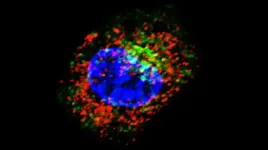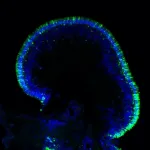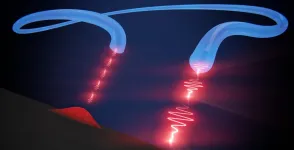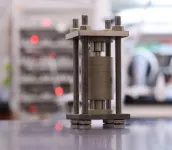(Press-News.org) Despite long-standing ideas about the importance of thumb evolution in tool use and development, questions remain about exactly when human-like manual dexterity and efficient thumb use arose--and which hominin species was the first to have this ability. Now, researchers who've analyzed the biomechanics and efficiency of the thumb across different fossil human species using virtual muscle modeling have new insight into when these abilities first arose and what they've meant for the development of more complex human culture. The findings, appearing January 28 in the journal Current Biology, suggest that a fundamental aspect of human thumb opposition first appeared approximately 2 million years ago and was not found in the earliest proposed stone tool makers.
"Increased manual dexterity in the form of efficient thumb opposition was among the early defining characteristics of our lineage, providing a formidable adaptive advantage to our ancestors," said Katerina Harvati of the Eberhard Karls University of Tübingen. "It is likely a crucial element underlying the development of complex culture over the last 2 million years, shaping our biocultural evolution."
Earlier attempts to study thumb dexterity evolution had relied on comparisons between the skeletal anatomy of modern humans and earlier hominin species. The assumption was that similarities in skeletal remains to the human form could be taken as evidence of dexterity. In the new study, the team led by Harvati took a new and more comprehensive approach.
"Our methodology integrates cutting-edge virtual muscle modeling with three-dimensional analysis of bone shape and size," first author and hand biomechanics expert Alexandros Karakostis, explains. "This process includes the precise 3D study of the areas of the bones where muscles attach in life. Importantly, we were able to validate the predictions of our models by confirming that the differences observed between living taxa--chimpanzees and modern humans--reflect those reported from past experimental studies."
By applying this new approach to answer the question, the researchers showed that thumb efficiency and dexterity had increased to a significant extent in hominins that lived 2 million years ago in South Africa. At the same time, they found that the degree of this dexterity was consistently lower in the earliest proposed tool-making species, the Australopithecines. That includes the species Australopithecus sediba, which is also dated to approximately 2 million years ago. That's notable because researchers had previously suggested that the human-like thumb proportions of A. sediba reflected tool-making capabilities.
"One of the greatest surprises was to find that hominin hand fossils from the Swartkrans site in South Africa, which date to ca. 2 million years ago and are attributed to either early Homo or to the extinct hominin side branch Paranthropus robustus, could achieve a thumb-using dexterity similar to that of modern humans," Karakostis said.
The new findings further show that later-arising species, belonging to our own genus Homo-- including Neanderthals as well as early and recent Homo sapiens--share similarly high degrees of manual dexterity. Those findings applied also to the small-brained species Homo naledi, despite the fact that this species has not yet been found in association with stone tools.
"These consistently high dexterity levels in species of Homo are indicative of the great adaptive value of thumb opposition for human biocultural evolution," Harvati says.
The researchers note that the most important implication of their new findings is that an early increase of thumb dexterity about 2 million years ago may have been a foundation for the gradual development of complex culture. They highlight that this timeframe includes important biocultural developments such as the appearance of the large-brained Homo erectus lineage and its dispersal out of Africa. Around the same time, humans gradually began to exploit animal resources and to rely more heavily on stone tool technologies.
The researchers now plan to look even more closely at specific groups, such as Neanderthals, so as to further elucidate the details of their manual dexterity and how they may have differed from that of modern humans. They'll also more closely investigate the habitual manual activities of early hominins to further shed light on the behaviors that marked the transition to systematic tool production and use among our distant ancestors.
INFORMATION:
This work was supported by the European Research Council, the German Research Foundation, and the Ministry of Science, Research, and the Arts Baden-Württemberg.
Current Biology, Karakostis et al.: "Biomechanics of the human thumb and the evolution of dexterity" https://www.cell.com/current-biology/fulltext/S0960-9822(20)31893-5
Current Biology (@CurrentBiology), published by Cell Press, is a bimonthly journal that features papers across all areas of biology. Current Biology strives to foster communication across fields of biology, both by publishing important findings of general interest and through highly accessible front matter for non-specialists. Visit: http://www.cell.com/current-biology. To receive Cell Press media alerts, contact press@cell.com.
What makes one person drive above the speed limit while another navigates steadily in the right lane? What motivates someone to leave a job with a steady paycheck to launch their own business while the other sticks to one employer for an entire career?
"People have different tendencies to engage in behavior that risks their health or that involve uncertainties about the future," says Gideon Nave, an assistant professor of marketing in Penn's Wharton School.
Yet explaining the origin of those tendencies, both in the genome and in the brain, has been challenging for researchers, partly because previous studies on ...
ANN ARBOR, Michigan -- It was an unexpected discovery that started with an analysis of more than 1,000 genes. The question: why game-changing cancer immunotherapy treatments work for only a fraction of patients.
The analysis shone a light on one that popped up repeatedly in patients and mouse models that did not respond to immune checkpoint therapy: stanniocalcin-1, a glycoprotein whose role in both tumors and immunology is largely unknown.
By following the trail from this surprising thread, a University of Michigan Rogel Cancer team uncovered how stanniocalcin-1, or STC1, works inside the cell to block a cellular "eat-me" signal that typically triggers the immune system to produce T cells to fight the tumor. The findings, published in ...
Scientists at the National Eye Institute (NEI) have developed a promising gene therapy strategy for a rare disease that causes severe vision loss in childhood. A form of Leber congenital amaurosis, the disease is caused by autosomal-dominant mutations in the CRX gene, which are challenging to treat with gene therapy. The scientists tested their approach using lab-made retinal tissues built from patient cells, called retinal organoids. This approach, which involved adding copies of the normal gene under its native control mechanism, partially restored CRX function. The study report appears today in Stem ...
In early October 2019, when an unknown caller rang EPFL professor Johan Gaume's cell phone, he could hardly have imagined that he was about to confront one of the greatest mysteries in Soviet history. At the other end of the line, a journalist from The New York Times asked for his expert insight into a tragedy that had occurred 60 years earlier in Russia's northern Ural Mountains - one that has since come to be known as the Dyatlov Pass Incident. Gaume, head of EPFL's Snow and Avalanche Simulation Laboratory (SLAB) and visiting fellow at the WSL Institute for Snow and Avalanche Research SLF, had never heard ...
Researchers at the University of Basel and Ruhr University Bochum have developed a source of single photons that can produce billions of these quantum particles per second. With its record-breaking efficiency, the photon source represents a new and powerful building-block for quantum technologies.
Quantum cryptography promises absolutely secure communications. A key component here are strings of single photons. Information can be stored in the quantum states of these light particles and transmitted over long distances. In the future, remote quantum processors will communicate with each other via single photons. And perhaps the processor itself will use photons as quantum bits for computing.
A basic prerequisite for such applications, however, is an efficient source ...
Using X-ray tomography, a research team has observed the internal evolution of the materials inside solid-state lithium batteries as they were charged and discharged. Detailed three-dimensional information from the research could help improve the reliability and performance of the batteries, which use solid materials to replace the flammable liquid electrolytes in existing lithium-ion batteries.
The operando synchrotron X-ray computed microtomography imaging revealed how the dynamic changes of electrode materials at lithium/solid-electrolyte interfaces determine the behavior of solid-state batteries. The researchers found that battery operation caused voids to form ...
Science is society's best method for understanding the world, yet many people in the field are unhappy with the way it works. Rules and procedures meant to promote innovative research can have perverse side-effects that harm both science and scientists. One of these - the 'priority rule' - rewards scientists who make discoveries with prestige, prizes and better career opportunities, depriving the runners-up of similar perks. Researchers at University of Technology Eindhoven (TU/e) and the Arizona State University in the US have developed a new model to better understand this rule, and see if current reforms to improve the system actually make sense. Their study was published in Nature Human Behaviour.
"Over the past decade, there have been growing concerns that something ...
What The Study Did: This study finds that being a health care worker isn't associated with poorer outcomes among patients hospitalized with COVID-19.
Authors: Nauzer Forbes, M.D., M.Sc., of the University of Calgary in Canada, is the corresponding author.
To access the embargoed study: Visit our For The Media website at this link https://media.jamanetwork.com/
(doi:10.1001/jamanetworkopen.2020.35699)
Editor's Note: The article includes conflict of interest disclosures. Please see the article for additional information, ...
Risky behaviors such as smoking, alcohol and drug use, speeding, or frequently changing sexual partners result in enormous health and economic consequences and lead to associated costs of an estimated 600 billion dollars a year in the US alone. In order to define measures that could reduce these costs, a better understanding of the basis and mechanisms of risk-taking is needed.
Functional and anatomical differences
UZH neuro-economists Goekhan Aydogan, Todd Hare and Christian Ruff, together with an international research team looked at the genetic characteristics that correlate with risk-taking behavior. Using a representative sample of 25,000 people, the researchers examined the relationship ...
BOSTON - A nationwide panel of experts has developed the first mammography guidelines for older survivors of breast cancer, providing a framework for discussions between survivors and their physicians on the pros and cons of screening in survivors' later years.
The guidelines, published online today in a paper in JAMA Oncology, recommend discontinuing routine mammograms for survivors with a life expectancy under five years; considering stopping screening for those with a 5-10-year life expectancy; and continuing mammography for those whose life expectancy is greater than 10 years. The guidelines will be complemented by printed materials to help survivors gauge their risk of cancer recurring in the breast and weigh the potential benefits and drawbacks of mammography with ...





